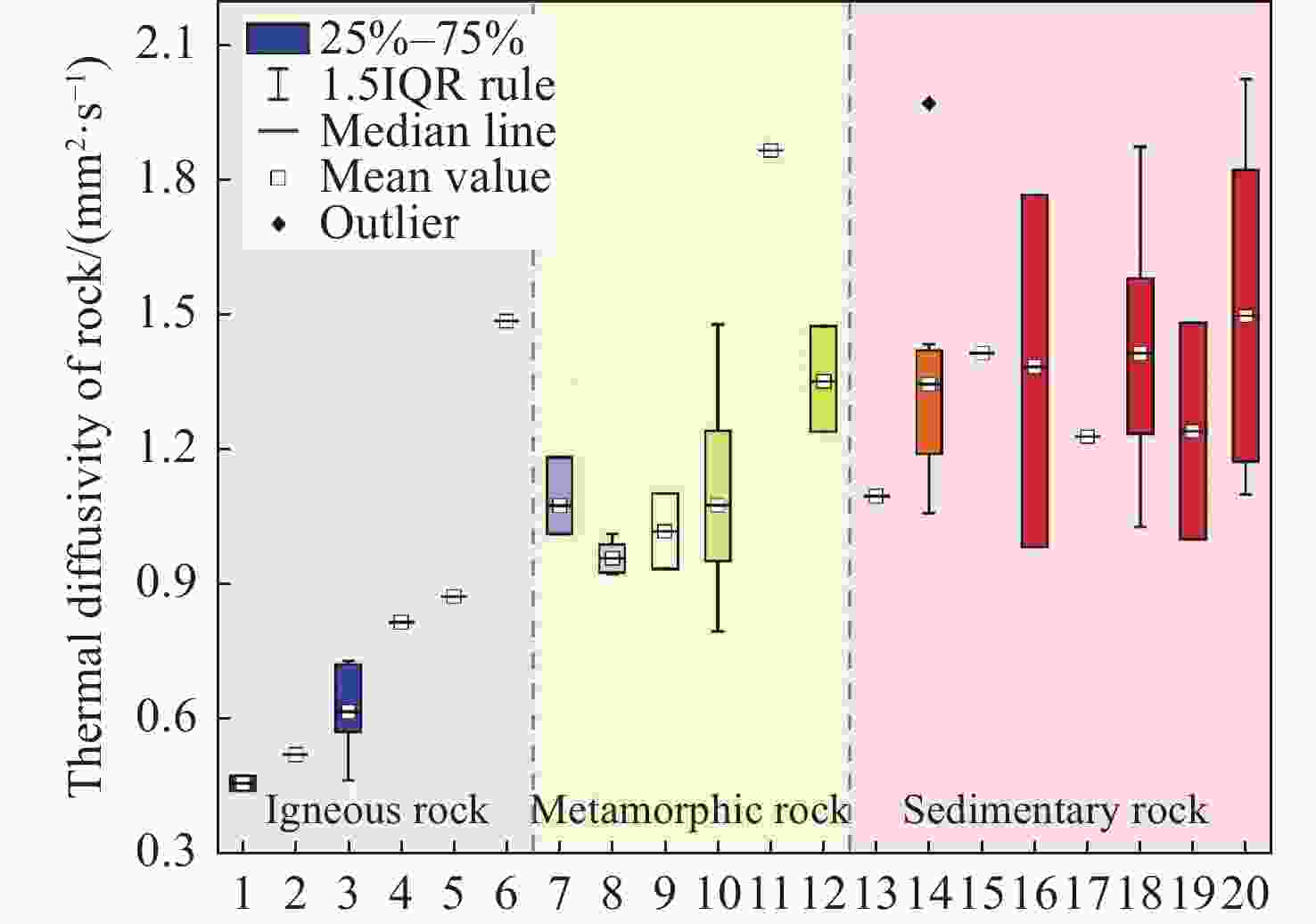Characterization of rock thermophysical properties and factors affecting thermal conductivity−A case study of Datong Basin, China
-
Abstract: Rock thermal physical properties play a crucial role in understanding deep thermal conditions, modeling the thermal structure of the lithosphere, and discovering the evolutionary history of sedimentary basins. Recent advancements in geothermal exploration, particularly the identification of high-temperature geothermal resources in Datong Basin, Shanxi, China, have opened new possibilities. This study aims to characterize the thermal properties of rocks and explore factors influencing thermal conductivity in basins hosting high-temperature geothermal resources. A total of 70 groups of rock samples were collected from outcrops in and around Datong Basin, Shanxi Province. Thermal property tests were carried out to analyze the rock properties, and the influencing factors of thermal conductivity were studied through experiments at different temperature and water-filled states. The results indicate that the thermal conductivity of rocks in Datong, Shanxi Province, typically ranges from 0.690 W/(m·K) to 6.460 W/(m·K), the thermal diffusion coefficient ranges from 0.441 mm2/s to 2.023 mm2/s, and the specific heat capacity of the rocks ranges from 0.569 KJ/(kg·°C) to 1.117 KJ/(kg·°C). Experimental results reveal the impact of temperature and water saturation on the thermal conductivity of the rock. The thermal conductivity decreases with increasing temperature and rises with high water saturation. A temperature correction formula for the thermal conductivity of different lithologies in the area is proposed through linear fitting. The findings from this study provide essential parameters for the assessment and prediction, development, and utilization of geothermal resources in the region and other basins with typical high-temperature geothermal resource.
-
Figure 2. NW-SE geologic structure profile of Datong Basin (The profile position is shown in Fig. 1C, quated from Pan et al. 2022)
Notes: 1-Archaic Sanggan Group; 2-Cambrian; 3-Ordovician; 4-Carboniferous series; 5-Permian system; 6-Lower Jurassic cohorts; 7-Yungang Group of Middle Jurassic; 8-Neogene lower member of Kezhai Formation; 9-Neogene middle section of Kezhai Formation; 10-Neogene Kezhai Formation upper member; 11-Neogene Nanyulin Formation; 12-Quaternary system; 13-Reverse fault; 14-Normal fault; 15-Thermal reservoir
Figure 4. Thermal conductivity box patterns of different lithologies in Datong Basin
Notes: The serial number of horizontal coordinate is expressed respectively: 1-tuff; 2-tuffaceous breccia; 3-basalt; 4-diabase; 5-monzonitic granite; 6-granite; 7-metagranulite; 8-granulite; 9-schist; 10-gneiss; 11-marble; 12-metamorphic granite; 13-mudstone; 14-limestone; 15-siltstone; 16-shale; 17-marl; 18-sandstone; 19-pebbly sandstone; 20-dolomite; 21-Soil (dry); 22-Soil (saturated)
Figure 5. Box diagram of rock thermal diffusivity in Datong Basin.
Notes: The serial number of horizontal coordinate is expressed respectively: 1-tuff; 2-tuffaceous breccia; 3-basalt; 4-diabase; 5-monzonitic granite; 6-granite; 7-granulite; 8-metagranulite; 9-schist; 10-gneiss; 11-marble; 12-metamorphic granite; 13-mudstone; 14-limestone; 15-fine sandstone; 16-shale; 17-marl; 18-sandstone; 19-pebbly sandstone; 20-dolomite
Figure 7. Box diagram of specific heat capacity of rocks in Datong Basin.
Notes: The X axis represents: 1-tuff; 2-basalt; 3-diabase; 4-monzonitic granite; 5-granite; 6-granulite; 7-metagranulite; 8-schist; 9-gneiss; 10-metamorphic granite; 11-mudstone; 12-limestone; 13-fine sandstone; 14-shale; 15-marl; 16-sandstone; 17-dolomite
Figure 10. Relationship between thermal conductivity and temperature of CaM (Meng et al. 2022)
Figure 12. Thermal conductivity of rocks under dry and water-saturated conditions
Notes: The serial number of horizontal coordinate is expressed respectively: 1-schist; 2-gneiss①; 3-limestone①; 4-limestone②; 5-sandstone①; 6-monzonitic granite; 7-dolomite①; 8-gneiss②; 9-mudstone; 10-sandstone②; 11-sandstone③; 12-sandstone④; 13-pebbly sandstone; 14-dolomite② (The upper corner marks represent different rock samples of the same lithology)
Table 1. Comparison between thermal conductivity of different lithologies and other areas of North China Craton
Lithology Datong basin W/(m·K)
(This text)Ordos Basin
W/(m·K)
(Sun et al. 1996)Qingshui Basin
W/(m·K)
(Sun et al. 2006; Qi, 2021)Jizhong Depression
W/(m·K)
(Su, 2021; Gao, 2023)Mudstone 2.961(1) 1.984±1.032(20) 1.820±0.820(18) 2.350(15) Sandstone 3.375±0.593(9) 2.943±1.008(46) 2.440±0.280(16) 2.150 Limestone 2.968±0.676(9) 3.668±1.110(10) 3.350±0.490(8) 3.920(9) Dolomite 5.451±1.486(4) 3.345±1.120(7) — 5.670(10) Gneiss 2.632±0.663(9) 1.786(1) — 2.590(11) Fine sandstone 2.997(1) — 2.260±0.740(18) — Granite 3.120(1) — 2.715 — Notes: Number of samples is shown in brackets Table 2. Data of rock thermal conductivity at different temperatures
Sample Number Temperature/°C Lithology 25°C 30°C 60°C 90°C 120°C 150°C 180°C Reduction/% GLX-10 Dolomite 6.460 5.701 5.460 5.131 4.727 4.569 4.128 36 GLX-2 Shale 3.873 3.742 3.430 3.484 3.140 2.984 2.876 26 GLX-8 Limestone 2.947 2.947 2.911 2.741 2.624 2.539 2.446 17 TZX-5 Metamonzonite granite 3.055 3.001 2.996 2.892 2.733 2.603 2.554 16 DTA-6 Monzonitic granite 2.264 2.264 2.254 2.246 2.209 2.153 2.119 6 DTB-1 Gneiss 1.939 1.896 1.900 1.894 1.864 1.836 1.821 6 Table 3. Temperature correction formula of rock thermal conductivity in Datong Basin
Sample Number Lithology Correction formula R2 GLX-10 Dolomite λ(T) = −0.0163(T−T0)+λ(T0) 0.895 GLX-2 Shale λ(T) = −0.0069(T−T0)+λ(T0) 0.918 GLX-8 Limestone λ(T) = −0.0034(T−T0)+λ(T0) 0.981 TZX-5 Metamonzonite granite λ(T) = −0.0033(T−T0)+λ(T0) 0.965 DTA-6 Monzonitic granite λ(T) = −0.0008(T−T0)+λ(T0) 0.918 DTB-1 Gneiss λ(T) = −0.0008(T−T0)+λ(T0) 0.979 Note: λ(T0) refers to the thermal conductivity value at room temperature and pressure. -
Cen M. 2015. Cenozoic tectonic evolution of Datong basin, northeastern margin of Ordos block. M. S. thesis. Hefei: Hefei University of Technology. (in Chinese) Cui JW, Hou LH, Zhu RK, et al. 2019. Thermal conductivity properties of rocks in the Chang 7 shale strata in the Ordos Basin and its implications for shale oil in situ development. Petroleum Geology & Experiment, 41(02): 280−288. (in Chinese) DOI: 10.11781/sysydz201902280. Feng JK, Yao HJ, Chen L, et al. 2022. Ongoing lithospheric alteration of the North China Craton revealed by surface-wave tomography and geodetic observations. Geophysical Research Letters, 49: e2022GL099403. DOI: 10.1029/2022GL099403. Gao P. 2015. Analysis of rock thermal physical parameters and research on multi-field thermal effect coupled model. Ph. D. thesis. Jilin: Jilin University. (in Chinese) Gao T. 2023. Present temperature field characteristics and influencing factors in Xiongxian geothermal field. M. S. thesis. Xian: Yangtze University. (in Chinese) Han Y, Bai XF, Zhang X. 2018. Discussion on geothermal resources and their exploitation and utilization mode in Shanxi Province. Geological Survey of China, 5(5): 13−20. (in Chinese) DOI: 10.19388/j.zgdzdc.2018.05.02. Hans-Dieter V, Rudiger S. 2003. Influence of temperature on thermal conductivity, thermal capacity and thermal diffusivity for different types of rock. Physics and Chemistry of the Earth, 28(9-11): 499−509. DOI: 10.1016/S1474-7065(03)00069-X. Jesse D, Merriman. 2023. A mineralogical model for thermal transport properties of rocks: Verification for low-porosity, crystalline rocks at ambient conditions. Journal of Petrology, 64: 1−30. DOI: 10.1093/petrology/egad012. Lei XD, Hu SB, Li J, et al. 2018. Thermal properties analysis of bedrock in Beijing. Progress in Geophysics, 33(05): 1814−1823. (in Chinese) DOI: 10.6038/pg2018BB0373. Li JS. 2009. Reservoir rock thermal physical property test. Journal of Daqing Petroleum Institute, 33(05): 23−26. (in Chinese) DOI: 10.3969/j.issn.2095-4107.2009.05.006. Li X, Zhu CQ, Qiu NS, et al. 2023. Thermal conductivity of rocks and its influencing factors in northern Songliao Basin. Acta Geoscientica Sinica, 44(01): 70−83. (in Chinese) DOI: 10.3975/cagsb.2022.092901. Liu AR, Xu YJ, Liu CL, et al. 2021. Geological characteristics and tectonic evolution of Datong Basin. Geoscience, 35(05): 1296−1310. (in Chinese) DOI: 10.19657/j.geoscience.1000-8527.2020.067. Liu F, Zhang W, Wang GL, et al. 2023. Geothermal anomalies in the Xianshuihe area: Implications for tunnel construction along the Sichuan-Tibet Railway, China. Journal of Groundwater Science and Engineering, 11(3): 237−248. DOI: 10.26599/JGSE.2023.9280020. Ma F, Wang GL, Sun ZX, et al. 2019. An analysis of thermal conductivity in Songliao basin based on logging parameters. Acta Geoscientica Sinica, 40(02): 350−360. (in Chinese) DOI: 10.3975/cagsb.2019.021101. Meng J, Li N, Dong P, et al. 2022. Effects of phonon scattering channel on abnormal thermal conductivity of CaO and CaS. Journal of Shenyang University of Technology, 44(05): 525−529. (in Chinese) DOI: 10.7688/j/issn.1000-1646.2022.05.08. Miao SQ, Li HP, Chen G, et al. 2013. Progress of high temperature and high pressure experimental study on the thermal conductivity of the minerals and rocks. Progress in Geophysics, 28(05): 2453−2466. (in Chinese) DOI: 10.6038/pg20130524. Pan LY, Meng LJ, Sun FL, et al. 2022. Geothermal geological characteristics and resource potential in the north of Datong Basin, Shanxi Province. Geology in China, 50 (6): 1632. (in Chinese) Qi K. 2021. Meso-Cenozoic lithospheric thermal-rheological structure and deep magmatic-thermal process in the WNCC. Ph. D. thesis. Xiaan: Northwest University. (in Chinese) Qiu NS. 2002. Characteristics of thermal conductivity and heat generation of rocks in basins in northwest China. Chinese Journal of Geology, (02): 196−206. (in Chinese) Seipold U, Huenges E. 1998. Thermal properties of gneisses and amphibolites—high pressure and high temperature investigations of ktb-rock samples. Tectonophysics, 291(1-4): 173−178. DOI: 10.1016/S0040-1951(98)00038-9. Seipold U. 1998. Temperature dependence of thermal transport properties of crystalline rocks a general law. Tectonophysics, 291(1-4): 161−171. DOI: 10.1016/S0040-1951(98)00037-7. Shi QL. 2019. Tectonic thermal evolution characteristics of the Datong Basin. M. S. thesis. Beijing: China University of Geosciences. (in Chinese) Song JJ, Wang GL, Xing LX, et al. 2023. Influencing factors of rock thermal conductivity and applicability evaluation of its mixing law predictive models. Geothermics, 110: 102680. DOI: 10.1016/j.geothermics.2023.102680. Song XQ, Jiang M, Peng Q, et al. 2019. Characteristics and influencing factors of thermal property parameters of main rock strata in Guizhou Province. Acta Geologica Sinica, 93(08): 2092−2103. (in Chinese) DOI: 10.19762/j.cnki.dizhixuebao.2019116. Su H. 2021. Thermal geochemical characteristics of typical geothermal fields in Jizhong Depression. M. S. thesis. Nanchang: East China University of Technology. (in Chinese) Sun SH, Liu SS, Wang J. 1996. Geothermal field and source rock evolution characteristics in Ordos Basin. Geotectonics and Metallogeny, (03): 255−261. (in Chinese) DOI: 10.16539/j.ddgzyckx.1996.03.008. Sun ZX, Zhang W, Hu BQ, et al. 2006. Features of heat flow and the geothermal field of the Qinshui Basin. Chinese Journal of Geophsics (S1): 93-98. (in Chinese) Tan FK. 2004. Contribution of lattice vibration to heat conduction. Journal of Minzu Normal University of Xingyi, (03): 71-73. (in Chinese) Tavman IH. 1996. Effective thermal conductivity of granular porous materials. International Communications in Heat and Mass Transfer, 23(2): 169−176. DOI: 10.1016/0735-1933(96)00003-6. Wang L, Ren Y, Deng F, et al. 2023. Study on calculation method of heat exchange capacity and thermal properties of buried pipes in the fractured rock mass-taking a project in carbonate rock area as an example. Energies, 16: 774. DOI: 10.3390/en16020774. Wang XJ. 2014. A brief analysis of the main thermal control structure and occurrence rule of geothermal resources in Shanxi Province. Huabei Natural Resources, 02: 85−87. (in Chinese) DOI: 10.3969/j.issn.1672-7487.2014.02.077. Wei SC, Liu F, Zhang W, et al. 2022. Research on the characteristics and influencing factors of terrestrial heat flow in Guizhou Province. Journal of Groundwater Science and Engineering, 10(2): 166−183. DOI: 10.19637/j.cnki.2305-7068.2022.02.006. Wu FY,Lin JQ,Wilde SA, et al. 2005. Nature and significance of the Early Cretaceous giant igneous event in eastern China. Earth and Planetary Science Letters, 233(1): 103−119. DOI: 10.1016/j.jpgl.2005.02.019. Xiong J, Lin HY, Ding HS, et al. 2020. Investigation on thermal property parameters characteristics of rocks and its influence factors. Natural Gas Industry, 7(3): 298−308. DOI: 10.1016/j.ngib.2020.04.001. Xu YL. 2015. The study on the formation and evolution of Datong Cenozoie Down-Faulted Basin. M. S. thesis. Taiyuan: Taiyuan University of Technology. (in Chinese) Yang SZ, Zhang WR, Shen XJ. 1986. Saturated water test study on thermal conductivity of porous rocks. Acta Petrologica Sinica, (04): 83−91. (in Chinese) DOI: 10.1007/BF02658170. Yu WQ. 2021. Deep process of thinning and destruction of heterogeneity in the North China Craton: Constraints from P-wave tomography. Institute of Geology, China Earthquake Administration. Zhang HY. 2016. Distribution and characteristics of geothermal resources in sedimentary basins in Shanxi Province. Huabei Natural Resources, (06): 115−116. (in Chinese) DOI: 10.3969/j.issn.1672-7487.2016.06.040. Zhang YL. 2019. Analysis of geothermal geological conditions in the area of Liudongying of Huairen sag in Datong Basin. Ground Water, 41(05): 15-17. (in Chinese) Zhao YX, Yang SZ, Zhang WR, et al. 1995. Temperature pressure experiment and analysis of rock thermal conductivity. Progress in Geophysics, 01: 104−113. (in Chinese) Zhong YT, Kusky T, Wang L, et al. 2021. Alpine-style nappes thrust over ancient North China continental margin demonstrate large Archean horizontal plate motions. Nature Communications. Zhou WL. 2021. Electrical structure of geothermal area in northeast of Datong Basin. Ph. D. thesis. Wuhan: China University of Geosciences. (in Chinese) Zhu CQ, Chen C, Yang YB, et al. 2022. Experimental study into the factors influencing rock thermal conductivity and their significance to geothermal resource assessment. Petroleum Science Bulletin, 7(03): 321−333. (in Chinese) DOI: 10.3969/j.issn.2096-1693.2022.03.029. Zhu RX. 2018. Conclusion summary of the major research project "Destruction of North China Craton". Science Foundation of China, 32(3): 282−290. (in Chinese) DOI: 10.16262/j.cnki.1000-8217.2018.03.008. -

 E-mail alert
E-mail alert Rss
Rss



 下载:
下载:



















